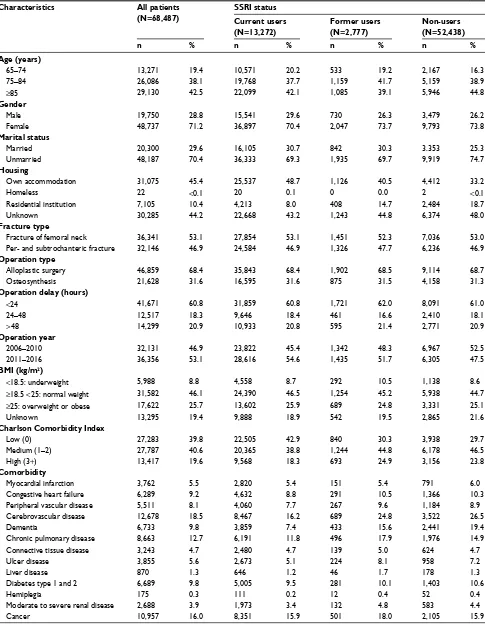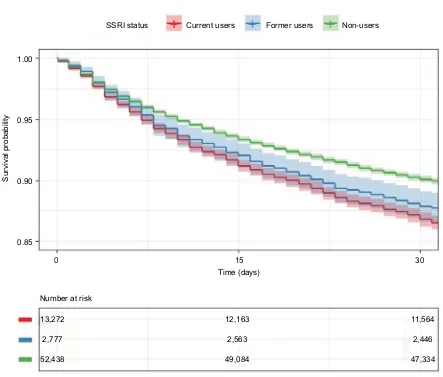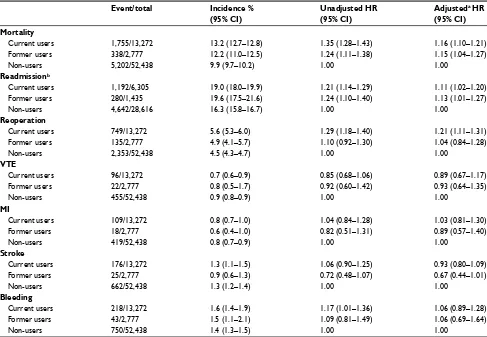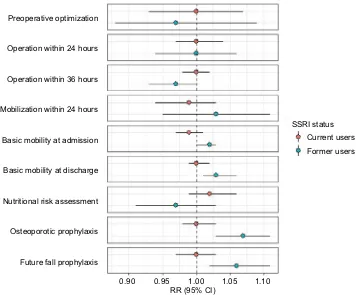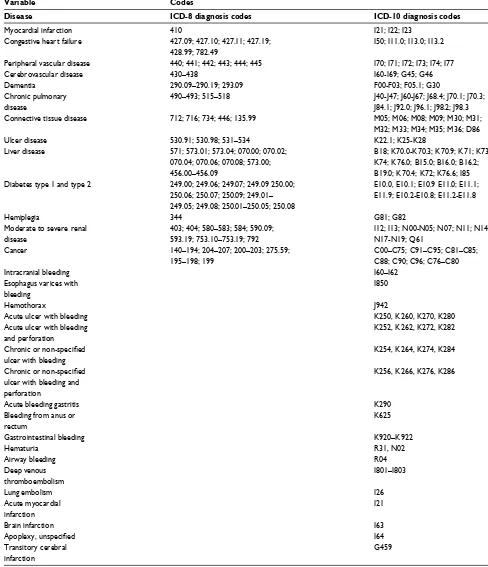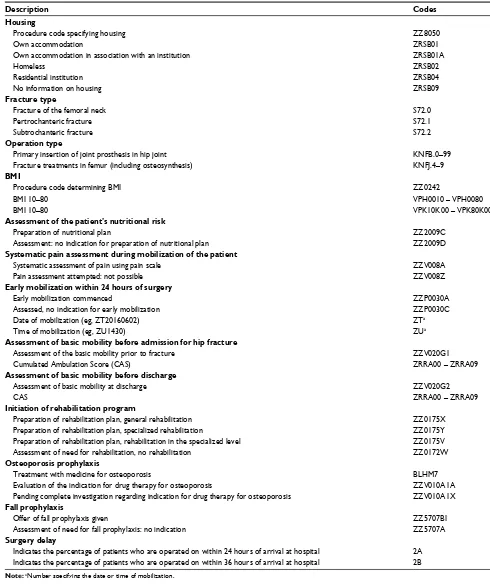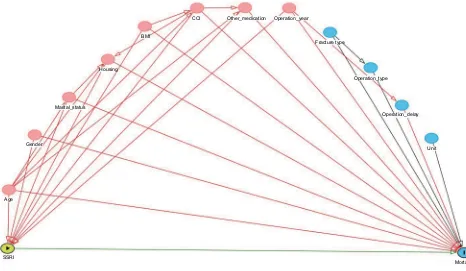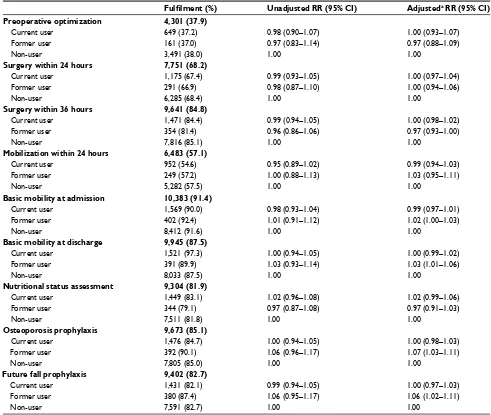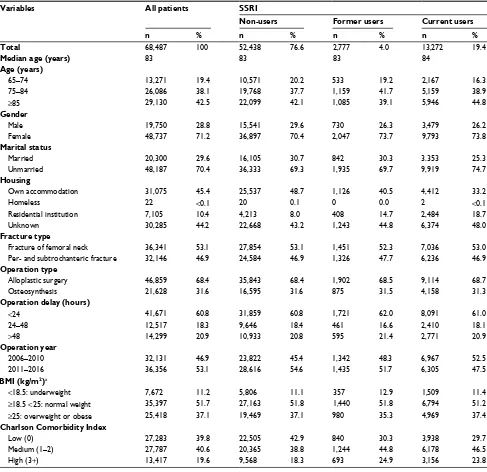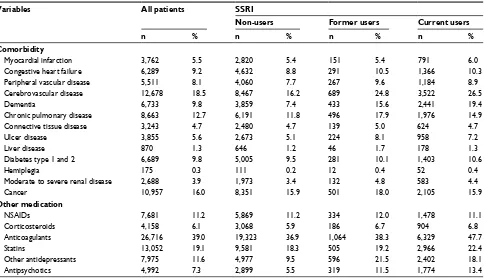Clinical Epidemiology
Dove
press
O r i g i n a l r E s E a r C h
open access to scientific and medical research
Open Access Full Text Article
selective serotonin reuptake inhibitor use and
mortality, postoperative complications, and
quality of care in hip fracture patients: a Danish
nationwide cohort study
stine Bakkensen Bruun1 irene Petersen1,2
nickolaj risbo Kristensen1 Deirdre Cronin-Fenton1 alma Becic Pedersen1
1Department of Clinical Epidemiology,
aarhus University hospital, aarhus, Denmark; 2Department of Primary
Care and Population health, University College london, london, UK
Purpose: To examine the association between selective serotonin reuptake inhibitor (SSRI)
use and mortality, postoperative complications, and quality of in-hospital care in hip fracture patients.
Patients and methods: The study was a nationwide cohort study based on individual-level
linked, prospectively collected data from Danish population-based national registries covering all hospitals in Denmark. The health care system in Denmark is tax-funded, and all citizens have equal access to health care services. We included patients with first-time hospitalization due to hip fracture undergoing surgery from 2006–2016. We estimated the risk of 30-day mortality, any unplanned readmission, any reoperation, specific postoperative complications including cardiovascular events and major bleeding, and quality of in-hospital care using Cox and Poisson regression analyses comparing current and former SSRI users with non-users.
Results: In 68,487 hip fracture patients, 13,272 (19%) were current SSRI users, 2,777 (4%)
were former SSRI users, and 52,438 (77%) were SSRI non-users. The 30-day mortality risk was 13% in current SSRI users (HR 1.16, 1.10–1.21) and 12% in former (HR 1.15, 1.04–1.27) compared with 10% in non-users. The HR for any unplanned readmission was 1.11 (1.02–1.20) in current and 1.13 (1.01–1.27) in former SSRI users and for any reoperation 1.21 (1.11–1.31) in current and 1.04 (0.84–1.28) in former SSRI users compared with non-users. The risk of venous thromboembolism, myocardial infarction, stroke, and bleeding were similar irrespective of SSRI use. No association between current and former SSRI use and quality of in-hospital care was found.
Conclusion: In patients undergoing hip fracture surgery, 30-day mortality and overall
readmis-sion risk were elevated in both current and former SSRI users compared with non-users. Those currently using SSRI had a 26% increased reoperation risk compared with non-users. However, SSRI use was not associated with increased risk of other postoperative complications and lower quality of in-hospital care. A limitation of this study was the inability to control for potential confounding of social deprivation.
Keywords: cohort studies, hip fracture, mortality, postoperative complications, quality of care,
selective serotonin reuptake inhibitors
Introduction
Hip fracture is a frequent surgical procedure among the elderly.1 It correlates with
high medical costs and health care utilization2 and confers increased risk of
mortal-ity.3 Thirty-day mortality in elderly surgically treated hip fracture patients is 10% and
Correspondence: stine Bakkensen Bruun Department of Clinical Epidemiology, aarhus University hospital, Olof Palmes allé 43-45, 8200 aarhus n, Denmark Tel +45 8 716 7212
Fax +45 8 716 7215 Email stinebb@post.au.dk
Journal name: Clinical Epidemiology Article Designation: Original Research Year: 2018
Volume: 10
Running head verso: Bruun et al
Running head recto: SSRI use and adverse outcomes in hip fracture patients DOI: http://dx.doi.org/10.2147/CLEP.S166309
Clinical Epidemiology downloaded from https://www.dovepress.com/ by 118.70.13.36 on 20-Aug-2020
For personal use only.
Dovepress
Bruun et al
increases to 30% within 1 year.4 Patients who receive the
recommended pre- and postoperative in-hospital care such as pain assessment, nutritional risk assessment, osteoporosis prophylaxis, and basic mobility assessment at admission and discharge may have a lower mortality risk compared with those who do not.5 Additionally, high mortality is linked to
the occurrence of postoperative complications, which affect ~20% of elderly hip fracture patients.5,6 The most common
postoperative complication is infection.4 However, patients
can experience venous thromboembolism (VTE), myocar-dial infarction (MI), stroke, and gastrointestinal bleeding as well.4,7
Elderly hip fracture patients are often multimorbid and receive multiple prescription medications including selective serotonin reuptake inhibitors (SSRIs).8 SSRIs
are prescribed to 10% of Danish elderly aged 65 years or older.9 The most common indications for SSRI prescribing
are depression and anxiety.10 In general, SSRI use appears
to increase the risk of mortality, new cardiovascular events, and postoperative bleeding.6,11 Previous studies among
patients undergoing major surgery, including orthopedic surgeries, reported higher risk of mortality, readmission, and blood transfusion in those using SSRIs perioperatively.12,13
However, a study including orthopedic patients showed no evidence that SSRI use increased the risk of receiving a blood transfusion.14 Thus, existing literature examining
the effect of SSRI use on surgery outcome is somewhat inconclusive. The impact of preadmission SSRI use on mortality, postoperative complications, and quality of in-hospital care among elderly and fragile hip fracture patients has not been reported previously. Therefore, we conducted a nationwide, prospective cohort study examining whether preadmission SSRI use is associated with adverse outcomes in hip fracture surgery patients.
Ethics approval
Ethical approval was not required according to the Danish Act on Research Ethics Review of Health Research Projects due to the register-based nature of the study. The study was approved by the Danish Data Protection Agency (record number: 1-16-02-467-15).
Patients and methods
setting and design
The study is a nationwide cohort study using prospectively collected data from Danish medical registries covering all Danish citizens; approximately 5.7 million people.15 The
health care system in Denmark is tax-funded, and all citizens have equal access to health care services.
Data sources
The Danish Multidisciplinary Hip Fracture Registry16 has
routinely registered comprehensive clinical data on all patients aged 65 years or older with first-time hip fracture admitted to any orthopedic department in Denmark since 2004. Data include detailed pre- and postoperative data, as well as data on quality of in-hospital care represented by process-performance measures. The Danish Civil Registra-tion System17 established in 1968 holds data on date of birth,
vital status, and migration on all individuals in Denmark. Every citizen has a unique civil personal registration number, which allows for individual-level linkage across all Danish registries. The Danish National Patient Registry18 contains
data on civil personal registration number, hospital admission and discharge diagnosis codes, and diagnostic and surgical procedure codes from all Danish somatic hospitals since 1977. Diagnoses were coded using the ICD-8 until the end of 1993 and ICD-10 thereafter. The Danish National Database of Reimbursed Prescriptions19 tracks reimbursed medicine
dispensing at all community pharmacies and hospital-based outpatient pharmacies in Denmark since 2004. The database holds data on civil personal registration number, Anatomical Therapeutic Chemical code, redemption date, item quantity, pack size, defined daily dose, dose form, and generic substi-tution done at pharmacy.
Participants
Patients aged 65 years or older undergoing surgical treatment for hip fracture between 2004 and 2016 were identified in the Danish Multidisciplinary Hip Fracture Registry. The study period was subsequently restricted to patients registered between January 1, 2006, and December 31, 2016, to ensure at least 2 years prescription history. Patients with missing data on operation delay (n=119) were excluded. In total, 68,487 first-time hip fracture patients who received surgery from 2006–2016 were available for analyses.
Variables
Exposure
All redeemed prescriptions for SSRIs 1 year before hip fracture surgery were identified in the Danish National Database of Reimbursed Prescriptions. Patients were classi-fied according to SSRI use. Current SSRI users redeemed at least one prescription within 90 days, former users redeemed
Clinical Epidemiology downloaded from https://www.dovepress.com/ by 118.70.13.36 on 20-Aug-2020
Dovepress ssri use and adverse outcomes in hip fracture patients
one prescription between 91 and 365 days, and non-users redeemed no prescriptions within 365 days before hip frac-ture surgery.
Outcomes
Several outcomes occurring after hip fracture surgery were examined separately. First, all-cause 30-day mortality was ascertained from the Civil Registration System. Second, postoperative complications were ascertained from the Dan-ish National Patient Registry. The following postoperative complications were examined: 1) any unplanned readmission, 2) any reoperation, 3) cardiovascular events including VTE, MI, and stroke, and 4) major bleeding defined as intracranial bleeding, gastrointestinal bleeding, or urinary/lung bleeding within 30 days of surgery. Third, quality of in-hospital care represented by process-performance measures20 including
preoperative optimization, operation delay, mobilization within 24 hours postoperatively, basic mobility assessment at admission and discharge, nutritional risk assessment, osteo-porosis prophylaxis, and future fall prophylaxis were obtained from the Danish Multidisciplinary Hip Fracture Registry.
Covariates
Operation year, housing, BMI, fracture type, operation type, and operation delay information was assessed from the Dan-ish Multidisciplinary Hip Fracture Registry. Four categories comprising housing information were created: own accom-modation, residential institution, homeless, and unknown. Likewise, four categories based on BMI values were cre-ated: underweight (BMI <18.5 kg/m2), normal weight (BMI ≥18.5 <25 kg/m2), overweight or obese (BMI ≥25 kg/m2),
and unknown. Age, gender, and marital status were obtained from the Danish Civil Registration System. Comorbidities were identified using the Danish National Patient Registry. Overall comorbidity was summarized according to the origi-nal Charlson Comorbidity Index (CCI) score. The CCI was categorized as low (score 0), medium (score 1–2), and high (score ≥3) comorbidity score, slightly modified compared with the original CCI.21 The following medications were
assessed from the Danish National Database of Reimbursed Prescriptions: non-steroidal anti-inflammatory drugs, corti-costeroids, anticoagulants, statins, non-SSRI antidepressants, and antipsychotics. Use of each medication was defined as follows: current users redeemed one prescription within 90 days, former users redeemed one prescription between 91 and 365 days, and non-users redeemed no prescriptions within 365 days before hip fracture surgery. All codes defining study variables are available in Tables S1–S3.
Statistical methods
Main analyses
Patient characteristics were tabulated according to SSRI use. All patients were followed from operation date to death, any unplanned readmission, any reoperation, cardiovascular event, bleeding event, or up to 30 days. Kaplan–Meier curves of the three SSRI exposure groups were plotted depicting the absolute mortality risk over time. The cumulative incidence of postoperative complications was estimated treating death as a competing risk. Crude and adjusted HRs with 95% CIs of death and postoperative complications within 30 days were estimated using Cox regression analysis comparing current and former SSRI users with non-users. The mortality model was evaluated for effect modification by age and gender. Readmission outcome data were only available for patients operated on from January 1, 2011 onward, thus readmission analyses were restricted to patients operated on between January 1, 2011 and December 31, 2016. RRs of quality of in-hospital care were estimated using Poisson regression analysis. The process-performance measures representing quality of in-hospital care were introduced in the Danish Multidisciplinary Hip Fracture Registry at various times. Therefore, the analyses regarding the quality of in-hospital care were performed only in hip fracture patients operated on between January 1, 2015 and December 31, 2016. Potential confounder assessment was done using a directed acyclic graph (Figure S1).22 All adjusted analyses accounted for age,
gender, marital status, operation year, comorbidities, other medication, and clustering by unit setting.
sensitivity analysis
Two sensitivity analyses were performed to test the robustness of the results. First, missing BMI values were imputed using multiple imputation (Supplementary materials).23 Missing
housing data were not imputed due to lack of predictors. Sec-ond, the exposure definition was changed to address potential compliance problems; current SSRI users redeemed two prescriptions within 2 years, of which one prescription was redeemed within 8 months before hip fracture, former users redeemed two prescriptions between 8 months and 2 years, and non-users redeemed one or no prescriptions within 2 years before hip fracture. The mortality analysis was repeated including BMI in the Cox regression model and employing a new exposure definition. Cox and Poisson regression analyses were performed using Stata 14 for Windows (StataCorp LP, College Station, TX, USA). The Kaplan–Meyer plot was produced using R for Windows 3.4.2 (The R Foundation for Statistical Computing, Vienna, Austria).
Clinical Epidemiology downloaded from https://www.dovepress.com/ by 118.70.13.36 on 20-Aug-2020
Dovepress
Bruun et al
Results
Patient characteristics
We identified 68,487 first-time hip fracture patients between 2006 and 2016. Of these, 13,272 (19%) were current SSRI users, 2,777 (4%) former, and 52,438 (77%) non-users. Table 1 presents the patient characteristics according to SSRI use. The median patient age was 84 years in current users (IQR 78–89 years) and 83 years in former users (IQR 77–88 years) and non-users (IQR 77–89 years). The current and former SSRI users had higher overall comorbidity than non-users, as well as higher prevalence of cerebrovascular disease, demen-tia, use of non-SSRI antidepressants, and antipsychotics. Current SSRI users had a higher prevalence of anticoagulant use than both former users and non-users (Table 1).
In total, 13,295 patients (19%) were missing BMI data and 30,285 (44%) patients were missing housing data. From the available housing data, we observed that SSRI non-users (25,537 [49%]) more often lived in their own accommoda-tion compared with current (4,412 [33%]) and former (1,126 [41%]) users. However, there was no difference in BMI distribution between the exposure groups (Table 1).
Mortality
Overall, 7,295 hip fracture patients died within the first 30 days following hip fracture surgery. Mortality was higher in current (13%) and former (12%) users compared with users (10%) (Figure 1 and Table 2). Compared with non-users, the adjusted HR was 1.16 (1.10–1.21) in current users and 1.15 (1.04–1.27) in former users (Table 2). We found no effect modification by age and gender of the relation between SSRI use and mortality.
readmission and reoperation
Table 2 shows cumulative incidences and HRs of any unplanned readmission and any reoperation within 30 days postoperatively. In total, 6,208 of 36,356 were readmitted and 2,327 of 68,487 re-operated within 30 days after surgery. Both current (HR 1.11, 1.02–1.20) and former users (HR 1.13, 1.01–1.27) had a higher readmission risk compared with non-users. Current SSRI users had a higher reoperation risk (HR 1.21, 1.11–1.31) compared with non-users while there was no difference between former users (HR 1.04, 0.84–1.28) and non-users.
Other postoperative complications
During the first 30 days following hip fracture surgery, 573 patients experienced VTE, 546 MI, 863 stroke, and 1,011 major bleeding. Table 2 shows cumulative incidences and HRs of the individual complications. Current SSRI users had
a similar risk of VTE (HR 0.89, 0.67–1.17), MI (HR 1.03, 0.81–1.30), stroke (HR 0.93, 0.80–1.09), and bleeding (HR 1.06, 0.89–1.28) as non-users. Likewise, former SSRI users had a similar risk of VTE (HR 0.93, 0.64–1.35), MI (HR 0.89, 0.57–1.40), stroke (HR 0.67, 0.44–1.01), and bleeding (HR 1.06, 0.69–1.64) as non-users.
Quality of in-hospital care
The analyses included 11,363 patients operated on during 2015–2016. Figure 2 shows a marginally higher chance of assessment of basic mobility at discharge, osteoporosis pro-phylaxis, and future fall prophylaxis in former SSRI users compared with non-users. Overall, there was no association between current and former SSRI use and quality of in-hospital care (Table S4).
sensitivity analysis
The HRs of mortality did not materially change after mul-tiple imputation of missing BMI values and adjustment for BMI (Tables S5 and S6). Changing the exposure definition, we identified 14,530 (21%) current SSRI users, 1,116 (2%) former users, and 52,841 (77%) non-users. Patient char-acteristics in the new exposure groups were similar to the patient characteristics of the exposure groups used in the main analysis and the HRs of mortality were similar to the main analysis results (Tables S7 and S8).
Discussion
In this nationwide cohort study of hip fracture surgery patients, 30-day mortality and overall readmission were ele-vated for both current and former SSRI users. Those currently using SSRIs had an increased reoperation risk compared with non-users. However, SSRI use was not associated with increased risk of cardiovascular and bleeding complications and inferior quality of in-hospital care.
strengths and limitations
The strengths of this study are the use of well-established, well-validated, and prospectively collected data from Danish population-based registries with complete follow-up.19,24–26
The registries originate from a tax-supported and uniformly organized health care system, reducing the risk of selection bias. The validity of the hip fracture diagnosis is high,27,28
and the complete follow-up reduces the risk of differential misclassification. In general, our study included all elderly hip fracture patients aged 65 years or older in Denmark between 2006 and 2016. These patients are similar regard-ing age and gender to those included in other studies on hip
Clinical Epidemiology downloaded from https://www.dovepress.com/ by 118.70.13.36 on 20-Aug-2020
Dovepress ssri use and adverse outcomes in hip fracture patients
Table 1 Baseline characteristics of hip fracture patients (n=68,487) according to preoperative selective serotonin reuptake inhibitor use 2006–2016
Characteristics All patients (N=68,487)
SSRI status Current users (N=13,272)
Former users (N=2,777)
Non-users (N=52,438)
n % n % n % n %
Age (years)
65–74 13,271 19.4 10,571 20.2 533 19.2 2,167 16.3
75–84 26,086 38.1 19,768 37.7 1,159 41.7 5,159 38.9
≥85 29,130 42.5 22,099 42.1 1,085 39.1 5,946 44.8
Gender
Male 19,750 28.8 15,541 29.6 730 26.3 3,479 26.2
Female 48,737 71.2 36,897 70.4 2,047 73.7 9,793 73.8
Marital status
Married 20,300 29.6 16,105 30.7 842 30.3 3.353 25.3
Unmarried 48,187 70.4 36,333 69.3 1,935 69.7 9,919 74.7
Housing
Own accommodation 31,075 45.4 25,537 48.7 1,126 40.5 4,412 33.2
homeless 22 <0.1 20 0.1 0 0.0 2 <0.1
residential institution 7,105 10.4 4,213 8.0 408 14.7 2,484 18.7
Unknown 30,285 44.2 22,668 43.2 1,243 44.8 6,374 48.0
Fracture type
Fracture of femoral neck 36,341 53.1 27,854 53.1 1,451 52.3 7,036 53.0
Per- and subtrochanteric fracture 32,146 46.9 24,584 46.9 1,326 47.7 6,236 46.9
Operation type
alloplastic surgery 46,859 68.4 35,843 68.4 1,902 68.5 9,114 68.7
Osteosynthesis 21,628 31.6 16,595 31.6 875 31.5 4,158 31.3
Operation delay (hours)
<24 41,671 60.8 31,859 60.8 1,721 62.0 8,091 61.0
24–48 12,517 18.3 9,646 18.4 461 16.6 2,410 18.1
>48 14,299 20.9 10,933 20.8 595 21.4 2,771 20.9
Operation year
2006–2010 32,131 46.9 23,822 45.4 1,342 48.3 6,967 52.5
2011–2016 36,356 53.1 28,616 54.6 1,435 51.7 6,305 47.5
BMI (kg/m2)
<18.5: underweight 5,988 8.8 4,558 8.7 292 10.5 1,138 8.6
≥18.5 <25: normal weight 31,582 46.1 24,390 46.5 1,254 45.2 5,938 44.7
≥25: overweight or obese 17,622 25.7 13,602 25.9 689 24.8 3,331 25.1
Unknown 13,295 19.4 9,888 18.9 542 19.5 2,865 21.6
Charlson Comorbidity Index
low (0) 27,283 39.8 22,505 42.9 840 30.3 3,938 29.7
Medium (1–2) 27,787 40.6 20,365 38.8 1,244 44.8 6,178 46.5
high (3+) 13,417 19.6 9,568 18.3 693 24.9 3,156 23.8
Comorbidity
Myocardial infarction 3,762 5.5 2,820 5.4 151 5.4 791 6.0
Congestive heart failure 6,289 9.2 4,632 8.8 291 10.5 1,366 10.3
Peripheral vascular disease 5,511 8.1 4,060 7.7 267 9.6 1,184 8.9
Cerebrovascular disease 12,678 18.5 8,467 16.2 689 24.8 3,522 26.5
Dementia 6,733 9.8 3,859 7.4 433 15.6 2,441 19.4
Chronic pulmonary disease 8,663 12.7 6,191 11.8 496 17.9 1,976 14.9
Connective tissue disease 3,243 4.7 2,480 4.7 139 5.0 624 4.7
Ulcer disease 3,855 5.6 2,673 5.1 224 8.1 958 7.2
liver disease 870 1.3 646 1.2 46 1.7 178 1.3
Diabetes type 1 and 2 6,689 9.8 5,005 9.5 281 10.1 1,403 10.6
hemiplegia 175 0.3 111 0.2 12 0.4 52 0.4
Moderate to severe renal disease 2,688 3.9 1,973 3.4 132 4.8 583 4.4
Cancer 10,957 16.0 8,351 15.9 501 18.0 2,105 15.9
(Continued)
Clinical Epidemiology downloaded from https://www.dovepress.com/ by 118.70.13.36 on 20-Aug-2020
Dovepress
Bruun et al
fractures in the elderly.4,7 To date, this is the largest study
examining the association between SSRI use and mortality, postoperative complications, and quality of in-hospital care in hip fracture patients.
We gathered comprehensive data on potential confound-ers including complete in-hospital comorbidity history
com-piled in the CCI26 and history of specific diseases. However,
we did not have information on the severity of diseases included in the CCI, on diseases treated in primary care, which were not severe enough to warrant a hospital diagno-sis, or information on the underlying disease indication for SSRI prescription. However, we included information on
Table 1 (Continued)
Characteristics All patients (N=68,487)
SSRI status Current users (N=13,272)
Former users (N=2,777)
Non-users (N=52,438)
n % n % n % n %
nsaiDs 7,681 11.2 5,869 11.2 334 12.0 1,478 11.1
Corticosteroids 4,158 6.1 3,068 5.9 186 6.7 904 6.8
anticoagulants 26,716 39.0 19,323 36.9 1,064 38.3 6,329 47.7
statins 13,052 19.1 9,581 18.3 505 19.2 2,966 22.4
non-ssri antidepressants 7,975 11.6 4,977 9.5 596 21.5 2,402 18.1
antipsychotics 4,992 7.3 2,899 5.5 319 11.5 1,774 13.4
Abbreviations: SSRI, selective serotonin reuptake inhibitor; NSAIDs, non-steroidal anti-inflammatory drugs.
1.00
SSRI status Current users Former users Non-users
0.95
Survival probabilit
y
0.90
0.85 0
Number at risk
13,272
2,777
52,438
12,163
2,563
49,084
11,564
2,446
47,334 15
Time (days)
30
Figure 1 Kaplan–Meyer survival curve showing mortality in hip fracture patients according to selective serotonin reuptake inhibitor (ssri) use 2006–2016.
Clinical Epidemiology downloaded from https://www.dovepress.com/ by 118.70.13.36 on 20-Aug-2020
Dovepress ssri use and adverse outcomes in hip fracture patients
other medication, which may indicate treatment of condi-tions not captured in the CCI. The registries we used did not contain information on socioeconomic status, smoking, alcohol use, and other lifestyle factors. Furthermore, almost half of the patients were missing data on housing, making control of confounding difficult. Thus, we were not able to control for the potential confounding of social deprivation and lack of these data may have resulted in unmeasured and residual confounding. Information on comorbidities, other medication, marital status, and unit setting may contribute to control of confounding, but is not an adequate measure of social deprivation.
We included former SSRI users as a negative control. That is, we anticipated that former users were more similar to current users than non-users regarding potential confounding factors such as socioeconomic status and lifestyle factors.
Thus, if the effect of SSRI exposure on mortality was caused by the medication itself, we would anticipate only seeing an effect in current users and not in former users. However, this was not the case, and the observed association between SSRI use and mortality may rather be caused by underlying risk factors.29
We did not have information about compliance. In our study, non-compliance would cause a misclassification of non-users as users, and therefore the observed association between SSRI use and mortality, readmission, or reopera-tion risk might actually be higher. However, as the patients redeemed the prescriptions, our estimates most likely reflect actual drug use. Even considering misclassification, dis-pensed prescriptions are considered a good measure of medi-cation intake.30 Furthermore, we had no data on in-hospital
medication use. This may not have influenced the outcome
Table 2 Cumulative incidences and hrs with 95% Cis of mortality, readmission, reoperation, and postoperative complications within 30 days of hip fracture surgery according to selective serotonin reuptake inhibitor (ssri) use 2006–2016 (n=68,487)
Event/total Incidence % (95% CI)
Unadjusted HR (95% CI)
Adjusteda HR
(95% CI) Mortality
Current users 1,755/13,272 13.2 (12.7–12.8) 1.35 (1.28–1.43) 1.16 (1.10–1.21)
Former users 338/2,777 12.2 (11.0–12.5) 1.24 (1.11–1.38) 1.15 (1.04–1.27)
non-users 5,202/52,438 9.9 (9.7–10.2) 1.00 1.00
Readmissionb
Current users 1,192/6,305 19.0 (18.0–19.9) 1.21 (1.14–1.29) 1.11 (1.02–1.20)
Former users 280/1,435 19.6 (17.5–21.6) 1.24 (1.10–1.40) 1.13 (1.01–1.27)
non-users 4,642/28,616 16.3 (15.8–16.7) 1.00 1.00
Reoperation
Current users 749/13,272 5.6 (5.3–6.0) 1.29 (1.18–1.40) 1.21 (1.11–1.31)
Former users 135/2,777 4.9 (4.1–5.7) 1.10 (0.92–1.30) 1.04 (0.84–1.28)
non-users 2,353/52,438 4.5 (4.3–4.7) 1.00 1.00
VTE
Current users 96/13,272 0.7 (0.6–0.9) 0.85 (0.68–1.06) 0.89 (0.67–1.17)
Former users 22/2,777 0.8 (0.5–1.7) 0.92 (0.60–1.42) 0.93 (0.64–1.35)
non-users 455/52,438 0.9 (0.8–0.9) 1.00 1.00
MI
Current users 109/13,272 0.8 (0.7–1.0) 1.04 (0.84–1.28) 1.03 (0.81–1.30)
Former users 18/2,777 0.6 (0.4–1.0) 0.82 (0.51–1.31) 0.89 (0.57–1.40)
non-users 419/52,438 0.8 (0.7–0.9) 1.00 1.00
Stroke
Current users 176/13,272 1.3 (1.1–1.5) 1.06 (0.90–1.25) 0.93 (0.80–1.09)
Former users 25/2,777 0.9 (0.6–1.3) 0.72 (0.48–1.07) 0.67 (0.44–1.01)
non-users 662/52,438 1.3 (1.2–1.4) 1.00 1.00
Bleeding
Current users 218/13,272 1.6 (1.4–1.9) 1.17 (1.01–1.36) 1.06 (0.89–1.28)
Former users 43/2,777 1.5 (1.1–2.1) 1.09 (0.81–1.49) 1.06 (0.69–1.64)
non-users 750/52,438 1.4 (1.3–1.5) 1.00 1.00
Notes: aadjusted for age, gender, marital status, operation year, Mi, congestive heart failure, peripheral vascular disease, dementia, chronic pulmonary disease, connective tissue disease, ulcer disease, liver disease, diabetes type 1 and 2, hemiplegia, moderate to severe renal disease, cancer, non-steroidal anti-inflammatory drugs, corticosteroids,
anticoagulants, statins, non-ssri antidepressants, antipsychotics, and clustering by unit setting. brestricted to hip fracture patients operated on between 2011 and 2016.
Abbreviations: VTE, venous thromboembolism; Mi, myocardial infarction.
Clinical Epidemiology downloaded from https://www.dovepress.com/ by 118.70.13.36 on 20-Aug-2020
Dovepress
Bruun et al
since hip fracture surgery is an acute procedure with short length of hospital stay.
Comparison with other studies
We observed an equally increased mortality risk in current and former SSRI users. This suggests that rather than being a risk factor in itself, SSRI use may be a marker of underlying risk factors such as psychiatric illness, socioeconomic status, and lifestyle factors (smoking, alcohol misuse, and physical inactivity). These results are consistent with those obtained by Auerbach et al, showing an increased mortality in SSRI users compared with non-users after major surgery, includ-ing approximately 2% hip fracture surgeries.12 However, the
association found by Auerbach et al was attenuated in patients with depression suggesting that the underlying psychiatric indication for SSRI use may explain the increased risk rather than SSRIs in itself.12 A meta-analysis by Maslej et al found
an increased mortality in antidepressant users compared to non-users in the general population independent of treatment indication.31 The most common indications for SSRI
treat-ment are depression and anxiety10 and a systematic review
by Eaton et al showed that depression and anxiety correlate with increased mortality.32 Mortality in hip fracture patients
may also be influenced by socioeconomic status,33 and
Marinacci et al found an association between lower educa-tion level and mortality.34 Lower education level is further
associated with increased risk of psychiatric admission due to schizophrenia, alcoholism, drug dependency, affective psychosis, neurosis, and personality disorder.35 Finally, Seitz
et al found no difference in 30-day mortality between cur-rent (9.1%) and former (9.4%) serotonergic antidepressant users undergoing hip fracture surgery.36 However, they did
not include a non-user group, which distorts the association between SSRI use and mortality.
Our findings of an increased overall readmission risk in current and former SSRI users compared with non-users is consistent with the findings reported by Auerbach et al in major surgery patients. In their study, this association persisted in patients receiving SSRIs for depression, but not in patients receiving SSRIs for other reasons.12 This
Preoperative optimization
Operation within 24 hours
Operation within 36 hours
Mobilization within 24 hours
Basic mobility at admission
Basic mobility at discharge
Nutritional risk assessment
Osteoporotic prophylaxis
Future fall prophylaxis
0.90 0.95 1.00 RR (95% CI)
SSRI status Current users Former users
1.05 1.10
Figure 2 adjusted rrs with 95% Cis of quality of in-hospital care comparing current and former selective serotonin reuptake inhibitor (ssri) users with non-users
(reference) 2015–2016 (n=11,363).
Notes: adjusted for age, gender, marital status, operation year, myocardial infarction, congestive heart failure, peripheral vascular disease, dementia, chronic pulmonary
disease, connective tissue disease, ulcer disease, liver disease, diabetes type 1 and 2, hemiplegia, moderate to severe renal disease, cancer, non-steroidal anti-inflammatory
drugs, corticosteroids, anticoagulants, statins, non-ssri antidepressants, antipsychotics, and clustering by unit setting.
Clinical Epidemiology downloaded from https://www.dovepress.com/ by 118.70.13.36 on 20-Aug-2020
Dovepress ssri use and adverse outcomes in hip fracture patients
also suggests that SSRI use may not be a risk factor in itself but a marker of underlying disease or risk factors. A meta-analysis by Pizzi et al found no association between SSRI use and readmission in patients with coronary heart disease and depression, further supporting our results that SSRI use may not be a risk factor in itself.37
Another important finding was that current SSRI users had an increased reoperation risk compared with non-users, whereas the risk was not elevated in former users. A possible explanation for this could be that SSRI use may increase the likelihood of complications necessitating reoperation. There are different reasons for performing reoperation, eg, wound dehiscence, infection, and bleeding,20 and these complications
may be more frequent in SSRI users. Gärtner et al found an association between SSRI use and reoperation due to bleed-ing after breast cancer surgery.38 However, Tully et al showed
no association between serotonergic antidepressant use and reoperation due to infection or bleeding after coronary artery bypass graft surgery.39 Further research is needed to establish
the association between SSRI use and reoperation risk due to different causes in hip fracture patients.
We found little evidence of an association between SSRI and the risk of VTE, MI, stroke, and bleeding. To our knowledge, no other studies have investigated the association between SSRI use and the previously mentioned postopera-tive complications following hip fracture surgery. Auerbach et al found an association between SSRI use and postopera-tive bleeding in major surgery patients. However, they had a broader bleeding definition, including bleeding following procedure, and they included both acute and elective opera-tions.12 Tully et al showed no association between SSRI use
and MI, stroke, or bleeding after coronary artery bypass graft surgery,39 supporting our findings.
The present study did not find any difference between SSRI non-users and users regarding quality of in-hospital care. This is important and in line with efforts of European govern-ments to reduce social inequality in treatment of patients.40
However, we have no information on quality of patient care outside hospital settings. Previous research suggests lower 30-day mortality in hip fracture patients who received higher quality of care.5 Quality of in-hospital care may not explain
the increased mortality associated with SSRI use in our study.
Implications of findings
One issue emerging from our findings is the question about discontinuation of SSRI treatment after hip fracture surgery. Since hip fracture is an acute condition, it is not possible to stop treatment before surgery. Our analysis suggests that stopping
SSRI treatment after surgery would not change the mortality and overall readmission since these were similar in current and former users compared with non-users. We found that overall reoperation was augmented in current users, but not in former users compared with non-users. However, pausing SSRI treatment without a complete discussion of the risks and benefits is unwarranted. Our findings call for increased clinical awareness of hip fracture patients using SSRIs as they may have an increased risk of mortality, unplanned readmission, and reoperation. This patient group may be more prone to adverse outcomes after surgery regardless of the indication for SSRI treatment and may benefit from improved models of care. The follow-up care in Denmark is carried out by the municipality. Our findings suggest that hip fracture patients currently or formerly using SSRIs may benefit from closer follow-up and better communication between hospital, municipality, and general practitioner. However, the content and implementation of such improvements are beyond the scope of this paper. In future studies, it may be relevant to investigate how social deprivation influences surgical outcomes for these patients.
Conclusion
Thirty-day mortality and overall readmission in hip fracture patients were elevated in both current and former SSRI users compared with non-users. Those currently using SSRIs had an increased overall reoperation risk compared with non-users. However, SSRI use was not associated with increased risk of cardiovascular and bleeding complications and lower quality of in-hospital care.
Data availability
The authors are not authorized to share the data as it were assessed via the data custodian, ie, the Danish National Data Board.
Acknowledgments
We thank the staff of the hospital departments caring for patients with hip fracture for their continuous effort and contribution to acquisition of the data in the Danish Multi-disciplinary Hip Fracture Registry. The Independent Research Fund Denmark (grant number 6120–00034) funded this work. The funder had no role in the study design; in the col-lection, analysis, and interpretation of data; in the writing of the report; and in the decision to submit the article for publication. The researchers are independent from the funder. The study results were presented at the Danish Orthopedic Society Congress in October 2017 and at the PhD Day at Aarhus University in January 2018.
Clinical Epidemiology downloaded from https://www.dovepress.com/ by 118.70.13.36 on 20-Aug-2020
Dovepress
Bruun et al
Author contributions
All authors made substantial contributions to conception and design, acquisition of data, or analysis and interpretation of data; took part in drafting the article or revising it critically for important intellectual content; gave final approval of the version to be published; and agree to be accountable for all aspects of the work.
Disclosure
The authors report no conflicts of interest in this work.
References
1. Requena G, Abbing-Karahagopian V, Huerta C, et al. Incidence rates and trends of hip/femur fractures in five European countries: comparison using e-healthcare records databases. Calcif Tissue Int. 2014;94(6):580–589.
2. Polinder S, Meerding WJ, van Baar ME, et al. Cost estimation of injury-related hospital admissions in 10 European countries. J Trauma. 2005;59(6):1283-1290.
3. de Luise C, Brimacombe M, Pedersen L, Sørensen HT. Comorbidity and mortality following hip fracture: a population-based cohort study.
Aging Clin Exp Res. 2008;20(5):412–418.
4. Roche JJ, Wenn RT, Sahota O, Moran CG. Effect of comorbidi-ties and postoperative complications on mortality after hip fracture in elderly people: prospective observational cohort study. BMJ. 2005;331(7529):1374.
5. Nielsen KA, Jensen NC, Jensen CM, et al. Quality of care and 30 day mortality among patients with hip fractures: a nationwide cohort study.
BMC Health Serv Res. 2009;9:186.
6. Coupland C, Dhiman P, Morriss R, Arthur A, Barton G, Hippisley-Cox J. Antidepressant use and risk of adverse outcomes in older people: population based cohort study. BMJ. 2011;343:d4551.
7. Lawrence VA, Hilsenbeck SG, Noveck H, Poses RM, Carson JL. Medi-cal complications and outcomes after hip fracture repair. Arch Intern Med. 2002;162(18):2053–2057.
8. Vieira ER, Palmer RC, Chaves PH. Prevention of falls in older people living in the community. BMJ. 2016;353:i1419.
9. Medstat.dk [homepage on the Internet]. The Danish Health Data Author-ity. Available from: http://medstat.dk/. Accessed July 5, 2018. 10. Noordam R, Aarts N, Verhamme KM, Sturkenboom MC, Stricker BH,
Visser LE. Prescription and indication trends of antidepressant drugs in the Netherlands between 1996 and 2012: a dynamic population-based study. Eur J Clin Pharmacol. 2015;71(3):369–375.
11. Wu CS, Chang CM, Chen CY, et al. Association between antidepressants and venous thromboembolism in Taiwan. J Clin Psychopharmacol. 2013;33(1):31–37.
12. Auerbach AD, Vittinghoff E, Maselli J, Pekow PS, Young JQ, Linde-nauer PK. Perioperative use of selective serotonin reuptake inhibi-tors and risks for adverse outcomes of surgery. JAMA Intern Med. 2013;173(12):1075–1081.
13. Movig KL, Janssen MW, de Waal Malefijt J, Kabel PJ, Leufkens HG, Egberts AC. Relationship of serotonergic antidepressants and need for blood transfusion in orthopedic surgical patients. Arch Intern Med. 2003;163(19):2354–2358.
14. van Haelst IM, Egberts TC, Doodeman HJ, et al. Use of serotonergic antidepressants and bleeding risk in orthopedic patients. Anesthesiology. 2010;112(3):631–636.
15. Statistics Denmark. Statistical Yearbook. 121th ed. Copenhagen: Sta-tistics Denmark; 2017.
16. Sørensen HT, Christensen T, Schlosser HK, Pedersen L. Use of
Medi-cal Databases in CliniMedi-cal Epidemiology. 2nd ed. Aarhus: SUN-TRYK,
Aarhus Universitet; 2009.
17. Schmidt M, Pedersen L, Sørensen HT. The Danish Civil Registration System as a tool in epidemiology. Eur J Epidemiol. 2014;29(8):541–549. 18. Schmidt M, Schmidt SA, Sandegaard JL, Ehrenstein V, Pedersen L,
Sørensen HT. The Danish National Patient Registry: a review of content, data quality, and research potential. Clin Epidemiol. 2015;7:449–490. 19. Johannesdottir SA, Horváth-Puhó E, Ehrenstein V, Schmidt M, Pedersen L, Sørensen HT. Existing data sources for clinical epidemiology: The Danish National Database of Reimbursed Prescriptions. Clin Epidemiol. 2012;4:303–313.
20. Centre for Clinical Epidemiology and Biostatistics North. The Danish
Multidisciplinary Hip Fracture Register - National Annual Report 2017:
The Danish Clinical Registries; 2017. Available from: https://www.sund-hed.dk/content/cms/62/4662_hofte-fraktur-%C3%A5rsrapport_2017. pdf. Accessed August 7, 2018. Danish.
21. Charlson ME, Pompei P, Ales KL, Mackenzie CR. A new method of classifying prognostic comorbidity in longitudinal studies: development and validation. J Chronic Dis. 1987;40(5):373–383.
22. Shrier I, Platt RW. Reducing bias through directed acyclic graphs. BMC
Med Res Methodol. 2008;8(1):70.
23. Pedersen AB, Mikkelsen EM, Cronin-Fenton D, et al. Missing data and multiple imputation in clinical epidemiological research. Clin
Epidemiol. 2017;9:157–166.
24. Sundbøll J, Adelborg K, Munch T, et al. Positive predictive value of cardiovascular diagnoses in the Danish National Patient Registry: a validation study. BMJ Open. 2016;6(11):e012832.
25. Wildenschild C, Mehnert F, Thomsen RW, et al. Registration of acute stroke: validity in the Danish Stroke Registry and the Danish National Registry of Patients. Clin Epidemiol. 2014;6:27–36.
26. Thygesen SK, Christiansen CF, Christensen S, Lash TL, Sørensen HT. The predictive value of ICD-10 diagnostic coding used to assess Charlson comorbidity index conditions in the population-based Danish National Registry of Patients. BMC Med Res Methodol. 2011;11:83. 27. Baron JA, Lu-Yao G, Barrett J, Mclerran D, Fisher ES. Internal
valida-tion of Medicare claims data. Epidemiology. 1994;5(5):541–544. 28. Hudson M, Avina-Zubieta A, Lacaille D, Bernatsky S, Lix L, Jean S.
The validity of administrative data to identify hip fractures is high--a systematic review. J Clin Epidemiol. 2013;66(3):278–285.
29. Lawlor DA, Tilling K, Davey Smith G. Triangulation in aetiological epidemiology. Int J Epidemiol. 2016;45(6):1866–1886.
30. Schneeweiss S, Avorn J. A review of uses of health care utilization databases for epidemiologic research on therapeutics. J Clin Epidemiol. 2005;58(4):323–337.
31. Maslej MM, Bolker BM, Russell MJ, et al. The mortality and myocar-dial effects of antidepressants are moderated by preexisting cardiovas-cular disease: a meta-analysis. Psychother Psychosom. 2017;86(5): 268–282.
32. Eaton WW, Martins SS, Nestadt G, Bienvenu OJ, Clarke D, Alexandre P. The burden of mental disorders. Epidemiol Rev. 2008;30:1–14. 33. Thorne K, Johansen A, Akbari A, Williams JG, Roberts SE. The
impact of social deprivation on mortality following hip fracture in England and Wales: a record linkage study. Osteoporos Int. 2016;27(9): 2727–2737.
34. Marinacci C, Grippo F, Pappagallo M, et al. Social inequalities in total and cause-specific mortality of a sample of the Italian population, from 1999 to 2007. Eur J Public Health. 2013;23(4):582–587.
35. Tiikkaja S, Sandin S, Malki N, Modin B, Sparén P, Hultman CM. Social class, social mobility and risk of psychiatric disorder--a population-based longitudinal study. PLoS One. 2013;8(11):e77975.
36. Seitz DP, Bell CM, Gill SS, et al. Risk of perioperative blood transfu-sions and postoperative complications associated with serotonergic antidepressants in older adults undergoing hip fracture surgery. J Clin
Psychopharmacol. 2013;33(6):790–798.
Clinical Epidemiology downloaded from https://www.dovepress.com/ by 118.70.13.36 on 20-Aug-2020
Dovepress ssri use and adverse outcomes in hip fracture patients
37. Pizzi C, Rutjes AW, Costa GM, Fontana F, Mezzetti A, Manzoli L. Meta-analysis of selective serotonin reuptake inhibitors in patients with depression and coronary heart disease. Am J Cardiol. 2011;107(7):972–979.
38. Gärtner R, Cronin-Fenton D, Hundborg HH, et al. Use of selective sero-tonin reuptake inhibitors and risk of re-operation due to post-surgical bleeding in breast cancer patients: a Danish population-based cohort study. BMC Surg. 2010;10:3.
39. Tully PJ, Cardinal T, Bennetts JS, Baker RA. Selective serotonin reuptake inhibitors, venlafaxine and duloxetine are associated with in hospital morbidity but not bleeding or late mortality after coronary artery bypass graft surgery. Heart Lung Circ. 2012;21(4):206–214.
40. World Health Organization Europe. Parma Declaration on Environment
and Health. Fifth Ministerial Conference on Environment and Health.
Parma, Italy; 2010. Available from: http://www.euro.who.int/__data/ assets/pdf_file/0011/78608/E93618.pdf. Accessed August 07, 2018.
Clinical Epidemiology downloaded from https://www.dovepress.com/ by 118.70.13.36 on 20-Aug-2020
Dovepress
Bruun et al
Supplementary materials
Table S1 iCD-8 and iCD-10 diagnosis codes from the Danish national Patient registry
Variable Codes
Disease ICD-8 diagnosis codes ICD-10 diagnosis codes
Myocardial infarction 410 i21; i22; i23
Congestive heart failure 427.09; 427.10; 427.11; 427.19; 428.99; 782.49
i50; i11.0; i13.0; i13.2 Peripheral vascular disease 440; 441; 442; 443; 444; 445 i70; i71; i72; i73; i74; i77
Cerebrovascular disease 430–438 i60-i69; g45; g46
Dementia 290.09–290.19; 293.09 F00-F03; F05.1; g30
Chronic pulmonary disease
490–493; 515–518 J40-J47; J60-J67; J68.4; J70.1; J70.3;
J84.1; J92.0; J96.1; J98.2; J98.3
Connective tissue disease 712; 716; 734; 446; 135.99 M05; M06; M08; M09; M30; M31;
M32; M33; M34; M35; M36; D86
Ulcer disease 530.91; 530.98; 531–534 K22.1; K25-K28
liver disease 571; 573.01; 573.04; 070.00; 070.02;
070.04; 070.06; 070.08; 573.00; 456.00–456.09
B18; K70.0-K70.3; K70.9; K71; K73; K74; K76.0; B15.0; B16.0; B16.2; B19.0; K70.4; K72; K76.6; i85 Diabetes type 1 and type 2 249.00; 249.06; 249.07; 249.09 250.00;
250.06; 250.07; 250.09; 249.01– 249.05; 249.08; 250.01–250.05; 250.08
E10.0, E10.1; E10.9 E11.0; E11.1; E11.9; E10.2-E10.8; E11.2-E11.8
hemiplegia 344 g81; g82
Moderate to severe renal disease
403; 404; 580–583; 584; 590.09; 593.19; 753.10–753.19; 792
i12; i13; n00-n05; n07; n11; n14; n17-n19; Q61
Cancer 140–194; 204–207; 200–203; 275.59;
195–198; 199
C00–C75; C91–C95; C81–C85; C88; C90; C96; C76–C80
intracranial bleeding i60–i62
Esophagus varices with bleeding
i850
hemothorax J942
acute ulcer with bleeding K250, K260, K270, K280
acute ulcer with bleeding and perforation
K252, K262, K272, K282
Chronic or non-specified
ulcer with bleeding
K254, K264, K274, K284
Chronic or non-specified
ulcer with bleeding and perforation
K256, K266, K276, K286
acute bleeding gastritis K290
Bleeding from anus or rectum
K625
gastrointestinal bleeding K920–K922
hematuria r31, n02
airway bleeding r04
Deep venous thromboembolism
i801–i803
lung embolism i26
acute myocardial infarction
i21
Brain infarction i63
Apoplexy, unspecified i64
Transitory cerebral infarction
g459
Clinical Epidemiology downloaded from https://www.dovepress.com/ by 118.70.13.36 on 20-Aug-2020
Dovepress ssri use and adverse outcomes in hip fracture patients
Table S2 Codes from the Danish Multidisciplinary hip Fracture registry
Description Codes
Housing
Procedure code specifying housing ZZ8050
Own accommodation ZrsB01
Own accommodation in association with an institution ZrsB01a
homeless ZrsB02
residential institution ZrsB04
no information on housing ZrsB09
Fracture type
Fracture of the femoral neck s72.0
Pertrochanteric fracture s72.1
subtrochanteric fracture s72.2
Operation type
Primary insertion of joint prosthesis in hip joint KnFB.0–99
Fracture treatments in femur (including osteosynthesis) KnFJ.4–9
BMI
Procedure code determining BMi ZZ0242
BMi 10–80 VPh0010 – VPh0080
BMi 10–80 VPK10K00 – VPK80K00
Assessment of the patient’s nutritional risk
Preparation of nutritional plan ZZ2009C
assessment: no indication for preparation of nutritional plan ZZ2009D
Systematic pain assessment during mobilization of the patient
systematic assessment of pain using pain scale ZZV008a
Pain assessment attempted: not possible ZZV008Z
Early mobilization within 24 hours of surgery
Early mobilization commenced ZZP0030a
assessed, no indication for early mobilization ZZP0030C
Date of mobilization (eg, ZT20160602) ZTa
Time of mobilization (eg, ZU1430) ZUa
Assessment of basic mobility before admission for hip fracture
assessment of the basic mobility prior to fracture ZZV020g1
Cumulated ambulation score (Cas) Zrra00 – Zrra09
Assessment of basic mobility before discharge
assessment of basic mobility at discharge ZZV020g2
Cas Zrra00 – Zrra09
Initiation of rehabilitation program
Preparation of rehabilitation plan, general rehabilitation ZZ0175X
Preparation of rehabilitation plan, specialized rehabilitation ZZ0175Y
Preparation of rehabilitation plan, rehabilitation in the specialized level ZZ0175V
assessment of need for rehabilitation, no rehabilitation ZZ0172W
Osteoporosis prophylaxis
Treatment with medicine for osteoporosis BlhM7
Evaluation of the indication for drug therapy for osteoporosis ZZV010a1a
Pending complete investigation regarding indication for drug therapy for osteoporosis ZZV010a1X
Fall prophylaxis
Offer of fall prophylaxis given ZZ5707B1
assessment of need for fall prophylaxis: no indication ZZ5707a
Surgery delay
indicates the percentage of patients who are operated on within 24 hours of arrival at hospital 2a indicates the percentage of patients who are operated on within 36 hours of arrival at hospital 2B
Note:anumber specifying the date or time of mobilization.
Clinical Epidemiology downloaded from https://www.dovepress.com/ by 118.70.13.36 on 20-Aug-2020
Dovepress
Bruun et al
Table S3 anatomical Therapeutic Chemical (aTC) codes from the Danish national Database of reimbursed Prescriptions
Selective serotonin reuptake inhibitor (SSRI) ATC codes
Citalopram n06aB04
Escitalopram n06aB10
Fluoxetine n06aB03
Fluvoxamine n06aB08
Paroxetine n06aB05
sertraline n06aB06
Other medication
non-ssri antidepressants n06aa, n06aF, n06ag, n06aX
antipsychotics n05a
antithrombotic medicine B01a
Non-steroidal anti-inflammatory drugs M01a
Corticosteroids h02aB
statins C10aa
Other_medication Operation_year
Fracture type
Operation_type
Operation_delay
Unit
Mortality CCI
BMI
Housing
Marital_status
Gender
Age
SSRI
Figure S1 Directed acyclic graph of the possible relationship between important covariates and mortality in hip fracture patients.
Abbreviations: ssri, selective serotonin reuptake inhibitor; CCi, Charlson Comorbidity index.
Clinical Epidemiology downloaded from https://www.dovepress.com/ by 118.70.13.36 on 20-Aug-2020
Dovepress ssri use and adverse outcomes in hip fracture patients
Table S4 Unadjusted and adjusted rrs with 95% Cis of quality of in-hospital care according to selective serotonin reuptake inhibitor (ssri) use 2015–2016 (n=11,363)
Fulfilment (%) Unadjusted RR (95% CI) Adjusteda RR (95% CI)
Preoperative optimization 4,301 (37.9)
Current user 649 (37.2) 0.98 (0.90–1.07) 1.00 (0.93–1.07)
Former user 161 (37.0) 0.97 (0.83–1.14) 0.97 (0.88–1.09)
non-user 3,491 (38.0) 1.00 1.00
Surgery within 24 hours 7,751 (68.2)
Current user 1,175 (67.4) 0.99 (0.93–1.05) 1.00 (0.97–1.04)
Former user 291 (66.9) 0.98 (0.87–1.10) 1.00 (0.94–1.06)
non-user 6,285 (68.4) 1.00 1.00
Surgery within 36 hours 9,641 (84.8)
Current user 1,471 (84.4) 0.99 (0.94–1.05) 1.00 (0.98–1.02)
Former user 354 (81.4) 0.96 (0.86–1.06) 0.97 (0.93–1.00)
non-user 7,816 (85.1) 1.00 1.00
Mobilization within 24 hours 6,483 (57.1)
Current user 952 (54.6) 0.95 (0.89–1.02) 0.99 (0.94–1.03)
Former user 249 (57.2) 1.00 (0.88–1.13) 1.03 (0.95–1.11)
non-user 5,282 (57.5) 1.00 1.00
Basic mobility at admission 10,383 (91.4)
Current user 1,569 (90.0) 0.98 (0.93–1.04) 0.99 (0.97–1.01)
Former user 402 (92.4) 1.01 (0.91–1.12) 1.02 (1.00–1.03)
non-user 8,412 (91.6) 1.00 1.00
Basic mobility at discharge 9,945 (87.5)
Current user 1,521 (97.3) 1.00 (0.94–1.05) 1.00 (0.99–1.02)
Former user 391 (89.9) 1.03 (0.93–1.14) 1.03 (1.01–1.06)
non-user 8,033 (87.5) 1.00 1.00
Nutritional status assessment 9,304 (81.9)
Current user 1,449 (83.1) 1.02 (0.96–1.08) 1.02 (0.99–1.06)
Former user 344 (79.1) 0.97 (0.87–1.08) 0.97 (0.91–1.03)
non-user 7,511 (81.8) 1.00 1.00
Osteoporosis prophylaxis 9,673 (85.1)
Current user 1,476 (84.7) 1.00 (0.94–1.05) 1.00 (0.98–1.03)
Former user 392 (90.1) 1.06 (0.96–1.17) 1.07 (1.03–1.11)
non-user 7,805 (85.0) 1.00 1.00
Future fall prophylaxis 9,402 (82.7)
Current user 1,431 (82.1) 0.99 (0.94–1.05) 1.00 (0.97–1.03)
Former user 380 (87.4) 1.06 (0.95–1.17) 1.06 (1.02–1.11)
non-user 7,591 (82.7) 1.00 1.00
Notes:aadjusted for age, gender, marital status, operation year, myocardial infarction, congestive heart failure, peripheral vascular disease, dementia, chronic pulmonary disease, connective tissue disease, ulcer disease, liver disease, diabetes type 1 and 2, hemiplegia, moderate to severe renal disease, cancer, non-steroidal anti-inflammatory
drugs, corticosteroids, anticoagulants, statins, non-ssri antidepressants, antipsychotics, and clustering by unit setting. The numbers in bold represent the total number of
patients fulfilling each process-performance measure.
Clinical Epidemiology downloaded from https://www.dovepress.com/ by 118.70.13.36 on 20-Aug-2020
Dovepress
Bruun et al
Sensitivity analyses
Multiple imputation
Methods
In the multiple imputation model, we included all variables that were in the subsequent analysis model: selective serotonin reuptake inhibitors (SSRIs), age, gender, marital status, opera-tion year, BMI, comorbidities, and other medicaopera-tion.
Further-more, some auxiliary variables such as operation delay, fracture type, operation type, and postoperative complications were included. Imputation of BMI values was done using truncated regression creating 20 imputed datasets. After imputation, the association between SSRI use and mortality was estimated in each imputed dataset. The measures of association from each imputed dataset were combined using Rubin’s rule.
Table S5 Baseline characteristics of hip fracture patients (n=68,487) according to preoperative selective serotonin reuptake inhibitor (ssri) use 2006–2016 after imputation of BMi
Variables All patients SSRI
Non-users Former users Current users
n % n % n % n %
Total 68,487 100 52,438 76.6 2,777 4.0 13,272 19.4
Median age (years) 83 83 83 84
Age (years)
65–74 13,271 19.4 10,571 20.2 533 19.2 2,167 16.3
75–84 26,086 38.1 19,768 37.7 1,159 41.7 5,159 38.9
≥85 29,130 42.5 22,099 42.1 1,085 39.1 5,946 44.8
Gender
Male 19,750 28.8 15,541 29.6 730 26.3 3,479 26.2
Female 48,737 71.2 36,897 70.4 2,047 73.7 9,793 73.8
Marital status
Married 20,300 29.6 16,105 30.7 842 30.3 3.353 25.3
Unmarried 48,187 70.4 36,333 69.3 1,935 69.7 9,919 74.7
Housing
Own accommodation 31,075 45.4 25,537 48.7 1,126 40.5 4,412 33.2
homeless 22 <0.1 20 0.1 0 0.0 2 <0.1
residential institution 7,105 10.4 4,213 8.0 408 14.7 2,484 18.7
Unknown 30,285 44.2 22,668 43.2 1,243 44.8 6,374 48.0
Fracture type
Fracture of femoral neck 36,341 53.1 27,854 53.1 1,451 52.3 7,036 53.0
Per- and subtrochanteric fracture 32,146 46.9 24,584 46.9 1,326 47.7 6,236 46.9
Operation type
alloplastic surgery 46,859 68.4 35,843 68.4 1,902 68.5 9,114 68.7
Osteosynthesis 21,628 31.6 16,595 31.6 875 31.5 4,158 31.3
Operation delay (hours)
<24 41,671 60.8 31,859 60.8 1,721 62.0 8,091 61.0
24–48 12,517 18.3 9,646 18.4 461 16.6 2,410 18.1
>48 14,299 20.9 10,933 20.8 595 21.4 2,771 20.9
Operation year
2006–2010 32,131 46.9 23,822 45.4 1,342 48.3 6,967 52.5
2011–2016 36,356 53.1 28,616 54.6 1,435 51.7 6,305 47.5
BMI (kg/m2)a
<18.5: underweight 7,672 11.2 5,806 11.1 357 12.9 1,509 11.4
≥18.5 <25: normal weight 35,397 51.7 27,163 51.8 1,440 51.8 6,794 51.2
≥25: overweight or obese 25,418 37.1 19,469 37.1 980 35.3 4,969 37.4
Charlson Comorbidity Index
low (0) 27,283 39.8 22,505 42.9 840 30.3 3,938 29.7
Medium (1–2) 27,787 40.6 20,365 38.8 1,244 44.8 6,178 46.5
high (3+) 13,417 19.6 9,568 18.3 693 24.9 3,156 23.8
(Continued)
Clinical Epidemiology downloaded from https://www.dovepress.com/ by 118.70.13.36 on 20-Aug-2020
Dovepress ssri use and adverse outcomes in hip fracture patients
Table S5 (Continued)
Variables All patients SSRI
Non-users Former users Current users
n % n % n % n %
Comorbidity
Myocardial infarction 3,762 5.5 2,820 5.4 151 5.4 791 6.0
Congestive heart failure 6,289 9.2 4,632 8.8 291 10.5 1,366 10.3
Peripheral vascular disease 5,511 8.1 4,060 7.7 267 9.6 1,184 8.9
Cerebrovascular disease 12,678 18.5 8,467 16.2 689 24.8 3,522 26.5
Dementia 6,733 9.8 3,859 7.4 433 15.6 2,441 19.4
Chronic pulmonary disease 8,663 12.7 6,191 11.8 496 17.9 1,976 14.9
Connective tissue disease 3,243 4.7 2,480 4.7 139 5.0 624 4.7
Ulcer disease 3,855 5.6 2,673 5.1 224 8.1 958 7.2
liver disease 870 1.3 646 1.2 46 1.7 178 1.3
Diabetes type 1 and 2 6,689 9.8 5,005 9.5 281 10.1 1,403 10.6
hemiplegia 175 0.3 111 0.2 12 0.4 52 0.4
Moderate to severe renal disease 2,688 3.9 1,973 3.4 132 4.8 583 4.4
Cancer 10,957 16.0 8,351 15.9 501 18.0 2,105 15.9
Other medication
nsaiDs 7,681 11.2 5,869 11.2 334 12.0 1,478 11.1
Corticosteroids 4,158 6.1 3,068 5.9 186 6.7 904 6.8
anticoagulants 26,716 39.0 19,323 36.9 1,064 38.3 6,329 47.7
statins 13,052 19.1 9,581 18.3 505 19.2 2,966 22.4
Other antidepressants 7,975 11.6 4,977 9.5 596 21.5 2,402 18.1
antipsychotics 4,992 7.3 2,899 5.5 319 11.5 1,774 13.4
Note:aBMi values from m =1 data.
Abbreviation: NSAIDs, non-steroidal anti-inflammatory drugs.
Table S6 incidences and hrs with 95% Cis of mortality within 30 days of hip fracture surgery according to selective serotonin reuptake inhibitor (ssri) use 2006–2016 (n=68,487) after imputation of BMi
Events Incidence (95% CI) Unadjusted HR (95% CI) Adjusteda HR (95% CI)
Current user 1,755 13.2 (12.7–12.8) 1.35 (1.28–1.43) 1.16 (1.10–1.22)
Former user 338 12.2 (11.0–12.5) 1.24 (1.11–1.38) 1.12 (1.00–1.24)
non-user 5,202 9.9 (9.7–10.2) 1.00 1.00
Notes:aadjusted for age, gender, marital status, BMi, operation year, myocardial infarction, congestive heart failure, peripheral vascular disease, dementia, chronic pulmonary disease, connective tissue disease, ulcer disease, liver disease, diabetes type 1 and 2, hemiplegia, moderate to severe renal disease, cancer, non-steroidal anti-inflammatory
drugs, corticosteroids, anticoagulants, statins, non-ssri antidepressants, antipsychotics, and clustering by unit setting.
Clinical Epidemiology downloaded from https://www.dovepress.com/ by 118.70.13.36 on 20-Aug-2020
Dovepress
Bruun et al
Table S7 Baseline characteristics of hip fracture patients (n=68,487) according to preoperative selective serotonin reuptake inhibitor
(SSRI) use 2006–2016 after changing the exposure definition
Variables All patients SSRIs
Non-users Former users Current users
n % n % n % n %
Total 68,487 100 52,841 77.2 1,116 1.6 14,530 21.2
Median age (years) 83 83 82 84
Age (years)
65–74 13,271 19.4 10,620 20.1 230 20.6 2,421 16.6
75–84 26,086 38.1 19,910 37.7 487 43.6 5,689 39.2
≥85 29,130 42.5 22,311 42.2 399 35.8 6,420 44.2
Gender
Male 19,750 28.8 15,690 29.7 274 24.5 3,786 26.1
Female 48,737 71.2 37,151 70.3 842 75.5 10,744 73.9
Marital status
Married 20,300 29.6 16,247 30.7 320 28.7 3,733 25.7
Unmarried 48,187 70.4 36,594 69.3 796 71.3 10,797 74.3
Housing
Own accommodation 31,075 45.4 25,728 48.7 414 37.1 4,933 33.9
homeless 22 <0.1 17 <0.1 3 0.3 2 <0.1
residential institution 7,150 10.4 4,232 8.0 190 17.0 2,683 18.5
Unknown 30,285 44.2 22,864 43.3 509 45.6 6,912 47.6
Fracture type
Fracture of femoral neck 36,341 53.1 28.073 53.1 595 53.3 7.673 52.8
Per- and subtrochanteric fracture 32,146 46.9 24,768 46.9 521 46.7 6,857 47.2
Operation type
alloplastic surgery 46,859 68.4 36,122 68.4 761 68.2 9,976 68.7
Osteosynthesis 21,628 31.6 16,719 31.6 355 31.8 4,554 31.3
Operation delay (hours)
<24 41,671 60.8 32,090 60.7 700 62.7 8,881 61.1
24–48 12,517 18.3 9,715 18.4 196 17.6 2,606 17.9
>48 14,299 20.9 11,036 20.9 220 19.7 3,043 21.0
Operation year
2006–2010 32,131 46.9 24,061 45.5 539 48.3 7,531 51.8
2011–2016 36,356 53.1 28,780 54.5 577 51.7 6,999 48.2
BMI (kg/m2)
<18.5: underweight 5,988 8.8 4,623 8.7 104 9.3 1,261 8.7
≥18.5 <25: normal weight 31,582 46.1 24,630 46.6 492 44.1 6,460 44.5
≥25: overweight or obese 17,622 25.7 13,616 25.8 292 26.2 3,714 25.5
Unknown 13,295 19.4 9,972 18.9 228 20.4 3,095 21.3
Charlson Comorbidity Index
low (0) 27,283 39.8 22,655 42.9 339 30.4 4,289 29.5
Medium (1–2) 27,787 40.6 20,544 38.9 494 44.3 6,749 46.5
high (3+) 13,417 19.6 9,642 18.2 283 25.3 3,492 24.0
Comorbidity
Myocardial infarction 3,762 5.5 2,848 5.4 57 5.1 857 5.9
Congestive heart failure 6,289 9.2 4,677 8.9 125 11.2 1,487 10.2
Peripheral vascular disease 5,511 8.1 4,092 7.7 112 10.0 1,307 9.0
Cerebrovascular disease 12,678 18.5 8,549 16.2 278 24.9 3,851 26.5
Dementia 6,733 9.8 3,891 7.4 172 15.4 2,670 18.4
Chronic pulmonary disease 8,663 12.7 6,229 11.8 187 16.8 2,247 15.5
Connective tissue disease 3,243 4.7 2,495 4.7 60 5.4 688 4.7
Ulcer disease 3,855 5.6 2,693 5.1 81 7.3 1,081 7.4
liver disease 870 1.3 647 1.2 24 2.2 199 1.4
Diabetes type 1 and 2 6,689 9.8 5,041 9.5 131 11.7 1,517 10.4
hemiplegia 175 0.3 112 0.2 3 0.3 60 0.4
Moderate to severe renal disease 2,688 3.9 1,995 3.8 54 4.8 639 4.4
Cancer 10,957 16.0 8,440 16.0 175 15.7 2,342 16.1
(Continued)
Clinical Epidemiology downloaded from https://www.dovepress.com/ by 118.70.13.36 on 20-Aug-2020
Dovepress
Clinical Epidemiology
Publish your work in this journal
Submit your manuscript here: https://www.dovepress.com/clinical-epidemiology-journal Clinical Epidemiology is an international, peer-reviewed, open access, online journal focusing on disease and drug epidemiology, identifica-tion of risk factors and screening procedures to develop optimal pre-ventative initiatives and programs. Specific topics include: diagnosis, prognosis, treatment, screening, prevention, risk factor modification,
systematic reviews, risk and safety of medical interventions, epidemiol-ogy and biostatistical methods, and evaluation of guidelines, translational medicine, health policies and economic evaluations. The manuscript management system is completely online and includes a very quick and fair peer-review system, which is all easy to use.
Dove
press
ssri use and adverse outcomes in hip fracture patients
Table S8 incidences and hrs with 95% Cis of mortality within 30 days of hip fracture surgery according to selective serotonin reuptake inhibitor (ssri) use 2006–2016 (n=68,487) after changing the exposure definition
Events Incidence (95% CI) Unadjusted HR (95% CI) Adjusteda HR (95% CI)
Current user 1,907 13.1 (12.6–13.7) 1.34 (1.27–1.41) 1.16 (1.10–1.21)
Former user 137 12.3 (10.5–14.4) 1.25 (1.05–1.48) 1.12 (0.97–1.30)
non-user 5,251 9.9 (9.7–10.2) 1.00 1.00
Notes:aadjusted for age, gender, marital status, operation year, myocardial infarction, congestive heart failure, peripheral vascular disease, dementia, chronic pulmonary disease, connective tissue disease, ulcer disease, liver disease, diabetes type 1 and 2, hemiplegia, moderate to severe renal disease, cancer, non-steroidal anti-inflammatory
drugs, corticosteroids, anticoagulants, statins, non-ssri antidepressants, antipsychotics, and clustering by unit setting.
Table S7 (Continued)
Variables All patients SSRIs
Non-users Former users Current users
n % n % n % n %
Other medication
nsaiDs 7,681 11.2 5,926 11.2 128 11.5 1,627 11.2
Corticosteroids 4,158 6.1 3,100 5.9 86 7.7 972 6.7
anticoagulants 26,716 39.0 19,520 36.9 425 38.1 6,771 46.6
statins 13,052 19.1 9,698 18.4 182 16.3 3,172 21.8
Other antidepressants 7,975 11.6 4,905 9.3 372 33.3 2,698 18.6
antipsychotics 4,992 7.3 2,897 5.5 165 14.8 1,930 13.3
Abbreviation: NSAIDs, non-steroidal anti-inflammatory drugs.
Clinical Epidemiology downloaded from https://www.dovepress.com/ by 118.70.13.36 on 20-Aug-2020
